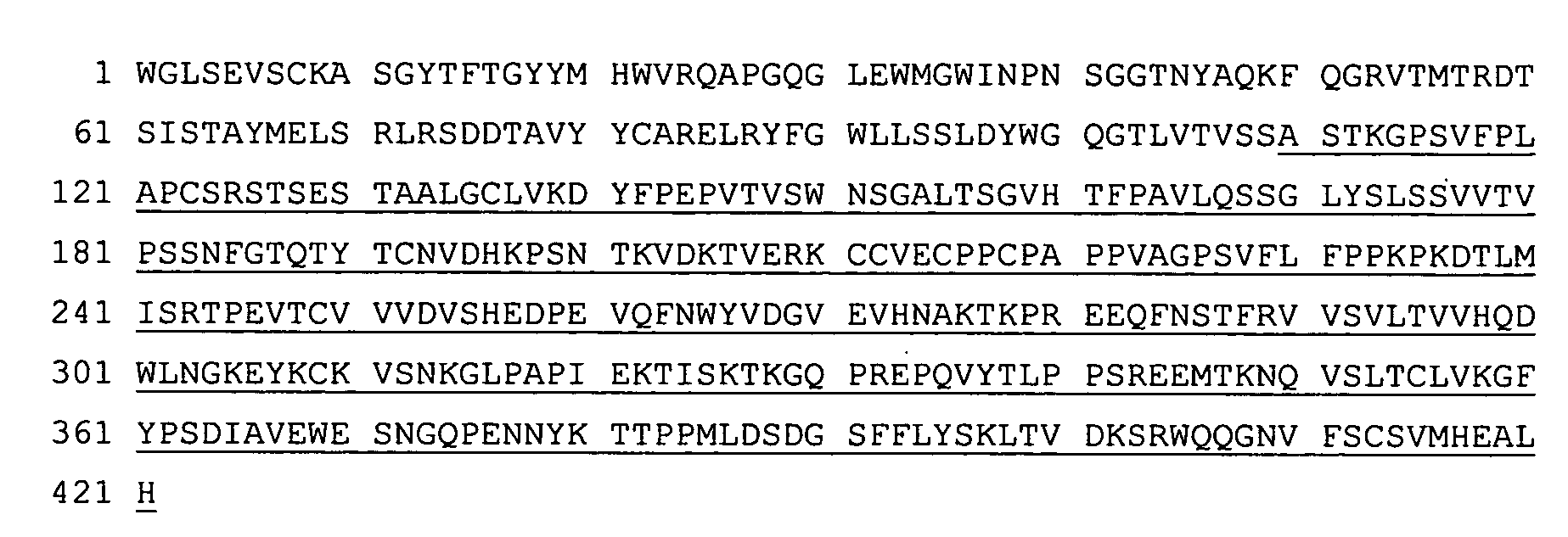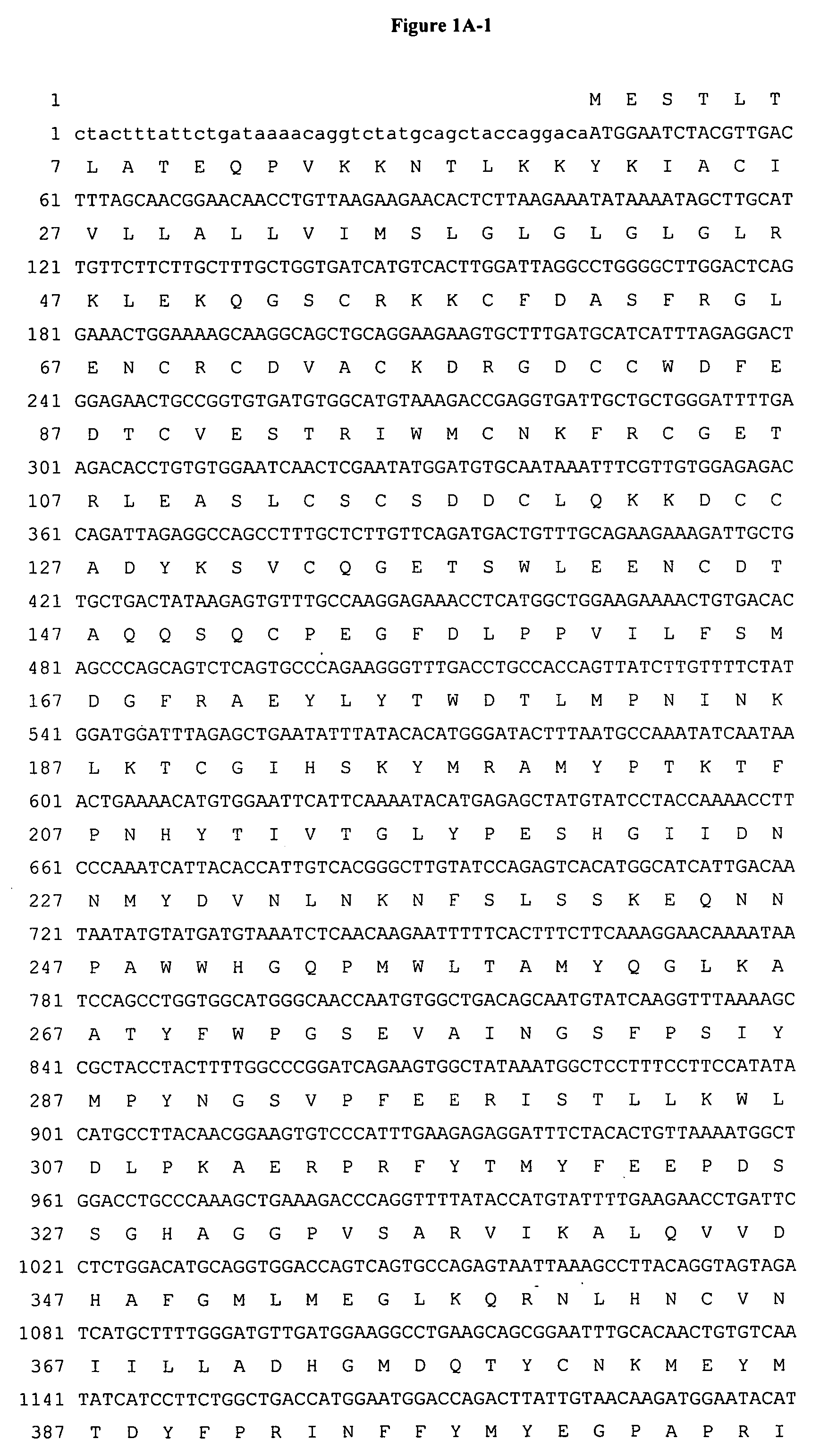Antibodies and related molecules that bind to 161P2F10B proteins
a technology of antibodies and related molecules, applied in antibody mimetics/scaffolds, fusion polypeptides, dna/rna fragmentation, etc., can solve the problems of ineffective treatment for many patients, undesirable consequences, and still no effective treatment for metastatic prostate cancer, so as to reduce the cell survival capacity of patients, inhibit proliferation, and induce the effect of apoptosis
- Summary
- Abstract
- Description
- Claims
- Application Information
AI Technical Summary
Benefits of technology
Problems solved by technology
Method used
Image
Examples
example 1
Expression Analysis of 161P2F10B Variants in Normal Tissues and Patient Specimens
[0703] To compare expression of 161P2F10B and 161P2F10B variants in normal versus patient cancer tissues, RT-PCR experiments were performed using normal and patient cancer tissues. First strand cDNA was generated from normal stomach, normal brain, normal heart, normal liver, normal skeletal muscle, normal testis, normal prostate, normal bladder, normal kidney, normal colon, normal lung, normal pancreas, and a pool of cancer specimens from prostate cancer patients, bladder cancer patients, kidney cancer patients, colon cancer patients, lung cancer patients, pancreas cancer patients, a pool of prostate cancer xenografts (LAPC-4AD, LAPC-4AI, LAPC-9AD and LAPC-9AI), and a pool of 2 patient prostate metastasis to lymph node. Normalization was performed by PCR using primers to actin. Semi-quantitative PCR, using primers to 161P2F10B, was performed at 26 and 30 cycles of amplification. Samples were run on an ...
example 2
Splice Variants of 161P2F10B
[0706] Transcript variants are variants of mature mRNA from the same gene, which arise by alternative transcription or alternative splicing. Alternative transcripts are transcripts from the same gene but start transcription at different points. Splice variants are mRNA variants spliced differently from the same transcript. In eukaryotes, when a multi-exon gene is transcribed from genomic DNA, the initial RNA is spliced to produce functional mRNA, which has only exons and is used for translation into an amino acid sequence. Accordingly, a given gene can have zero to many alternative transcripts and each transcript can have zero to many splice variants. Each transcript variant has a unique exon makeup, and can have different coding and / or non-coding (5′ or 3′ end) portions, from the original transcript. Transcript variants can code for similar or different proteins with the same or a similar function or can encode proteins with different functions, and can...
example 3
Single Nucleotide Polymorphisms of 161P2F10B
[0712] A Single Nucleotide Polymorphism (SNP) is a single base pair variation in a nucleotide sequence at a specific location. At any given point of the genome, there are four possible nucleotide base pairs: A / T, C / G, G / C and T / A. Genotype refers to the specific base pair sequence of one or more locations in the genome of an individual. Haplotype refers to the base pair sequence of more than one location on the same DNA molecule (or the same chromosome in higher organisms), often in the context of one gene or in the context of several tightly linked genes. SNPs that occur on a cDNA are called cSNPs. These cSNPs may change amino acids of the protein encoded by the gene and thus change the functions of the protein. Some SNPs cause inherited diseases; others contribute to quantitative variations in phenotype and reactions to environmental factors including diet and drugs among individuals. Therefore, SNPs and / or combinations of alleles (call...
PUM
| Property | Measurement | Unit |
|---|---|---|
| fluorescent | aaaaa | aaaaa |
| bioluminescent | aaaaa | aaaaa |
| chemiluminescent | aaaaa | aaaaa |
Abstract
Description
Claims
Application Information
 Login to View More
Login to View More - R&D
- Intellectual Property
- Life Sciences
- Materials
- Tech Scout
- Unparalleled Data Quality
- Higher Quality Content
- 60% Fewer Hallucinations
Browse by: Latest US Patents, China's latest patents, Technical Efficacy Thesaurus, Application Domain, Technology Topic, Popular Technical Reports.
© 2025 PatSnap. All rights reserved.Legal|Privacy policy|Modern Slavery Act Transparency Statement|Sitemap|About US| Contact US: help@patsnap.com



